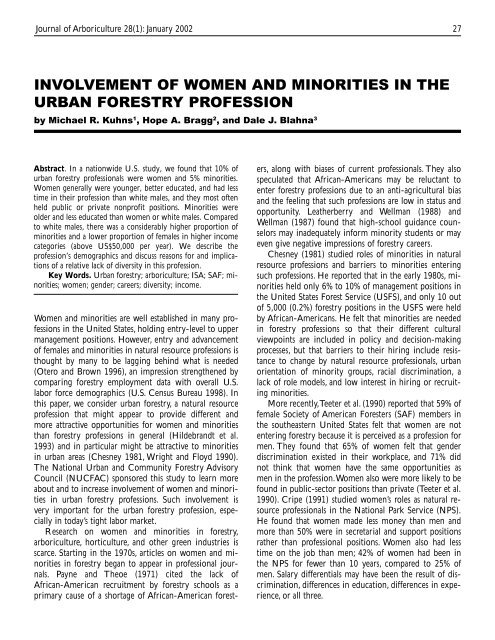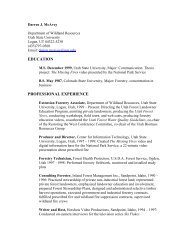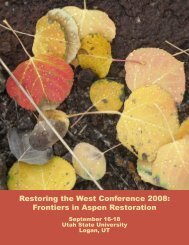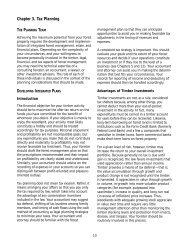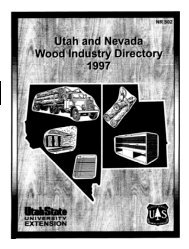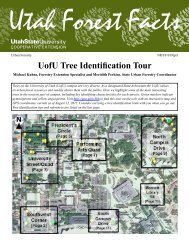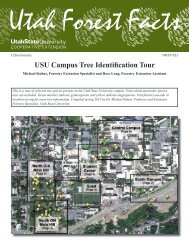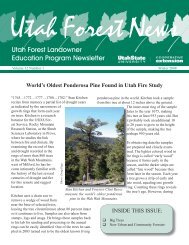involvement of women and minorities in the urban forestry ... - TreeLink
involvement of women and minorities in the urban forestry ... - TreeLink
involvement of women and minorities in the urban forestry ... - TreeLink
You also want an ePaper? Increase the reach of your titles
YUMPU automatically turns print PDFs into web optimized ePapers that Google loves.
Journal <strong>of</strong> Arboriculture 28(1): January 2002<br />
27<br />
INVOLVEMENT OF WOMEN AND MINORITIES IN THE<br />
URBAN FORESTRY PROFESSION<br />
by Michael R. Kuhns 1 , Hope A. Bragg 2 , <strong>and</strong> Dale J. Blahna 3<br />
Abstract. In a nationwide U.S. study, we found that 10% <strong>of</strong><br />
<strong>urban</strong> <strong>forestry</strong> pr<strong>of</strong>essionals were <strong>women</strong> <strong>and</strong> 5% <strong>m<strong>in</strong>orities</strong>.<br />
Women generally were younger, better educated, <strong>and</strong> had less<br />
time <strong>in</strong> <strong>the</strong>ir pr<strong>of</strong>ession than white males, <strong>and</strong> <strong>the</strong>y most <strong>of</strong>ten<br />
held public or private nonpr<strong>of</strong>it positions. M<strong>in</strong>orities were<br />
older <strong>and</strong> less educated than <strong>women</strong> or white males. Compared<br />
to white males, <strong>the</strong>re was a considerably higher proportion <strong>of</strong><br />
<strong>m<strong>in</strong>orities</strong> <strong>and</strong> a lower proportion <strong>of</strong> females <strong>in</strong> higher <strong>in</strong>come<br />
categories (above US$50,000 per year). We describe <strong>the</strong><br />
pr<strong>of</strong>ession’s demographics <strong>and</strong> discuss reasons for <strong>and</strong> implications<br />
<strong>of</strong> a relative lack <strong>of</strong> diversity <strong>in</strong> this pr<strong>of</strong>ession.<br />
Key Words. Urban <strong>forestry</strong>; arboriculture; ISA; SAF; <strong>m<strong>in</strong>orities</strong>;<br />
<strong>women</strong>; gender; careers; diversity; <strong>in</strong>come.<br />
Women <strong>and</strong> <strong>m<strong>in</strong>orities</strong> are well established <strong>in</strong> many pr<strong>of</strong>essions<br />
<strong>in</strong> <strong>the</strong> United States, hold<strong>in</strong>g entry-level to upper<br />
management positions. However, entry <strong>and</strong> advancement<br />
<strong>of</strong> females <strong>and</strong> <strong>m<strong>in</strong>orities</strong> <strong>in</strong> natural resource pr<strong>of</strong>essions is<br />
thought by many to be lagg<strong>in</strong>g beh<strong>in</strong>d what is needed<br />
(Otero <strong>and</strong> Brown 1996), an impression streng<strong>the</strong>ned by<br />
compar<strong>in</strong>g <strong>forestry</strong> employment data with overall U.S.<br />
labor force demographics (U.S. Census Bureau 1998). In<br />
this paper, we consider <strong>urban</strong> <strong>forestry</strong>, a natural resource<br />
pr<strong>of</strong>ession that might appear to provide different <strong>and</strong><br />
more attractive opportunities for <strong>women</strong> <strong>and</strong> <strong>m<strong>in</strong>orities</strong><br />
than <strong>forestry</strong> pr<strong>of</strong>essions <strong>in</strong> general (Hildebr<strong>and</strong>t et al.<br />
1993) <strong>and</strong> <strong>in</strong> particular might be attractive to <strong>m<strong>in</strong>orities</strong><br />
<strong>in</strong> <strong>urban</strong> areas (Chesney 1981, Wright <strong>and</strong> Floyd 1990).<br />
The National Urban <strong>and</strong> Community Forestry Advisory<br />
Council (NUCFAC) sponsored this study to learn more<br />
about <strong>and</strong> to <strong>in</strong>crease <strong><strong>in</strong>volvement</strong> <strong>of</strong> <strong>women</strong> <strong>and</strong> <strong>m<strong>in</strong>orities</strong><br />
<strong>in</strong> <strong>urban</strong> <strong>forestry</strong> pr<strong>of</strong>essions. Such <strong><strong>in</strong>volvement</strong> is<br />
very important for <strong>the</strong> <strong>urban</strong> <strong>forestry</strong> pr<strong>of</strong>ession, especially<br />
<strong>in</strong> today’s tight labor market.<br />
Research on <strong>women</strong> <strong>and</strong> <strong>m<strong>in</strong>orities</strong> <strong>in</strong> <strong>forestry</strong>,<br />
arboriculture, horticulture, <strong>and</strong> o<strong>the</strong>r green <strong>in</strong>dustries is<br />
scarce. Start<strong>in</strong>g <strong>in</strong> <strong>the</strong> 1970s, articles on <strong>women</strong> <strong>and</strong> <strong>m<strong>in</strong>orities</strong><br />
<strong>in</strong> <strong>forestry</strong> began to appear <strong>in</strong> pr<strong>of</strong>essional journals.<br />
Payne <strong>and</strong> Theoe (1971) cited <strong>the</strong> lack <strong>of</strong><br />
African-American recruitment by <strong>forestry</strong> schools as a<br />
primary cause <strong>of</strong> a shortage <strong>of</strong> African-American foresters,<br />
along with biases <strong>of</strong> current pr<strong>of</strong>essionals. They also<br />
speculated that African-Americans may be reluctant to<br />
enter <strong>forestry</strong> pr<strong>of</strong>essions due to an anti-agricultural bias<br />
<strong>and</strong> <strong>the</strong> feel<strong>in</strong>g that such pr<strong>of</strong>essions are low <strong>in</strong> status <strong>and</strong><br />
opportunity. Lea<strong>the</strong>rberry <strong>and</strong> Wellman (1988) <strong>and</strong><br />
Wellman (1987) found that high-school guidance counselors<br />
may <strong>in</strong>adequately <strong>in</strong>form m<strong>in</strong>ority students or may<br />
even give negative impressions <strong>of</strong> <strong>forestry</strong> careers.<br />
Chesney (1981) studied roles <strong>of</strong> <strong>m<strong>in</strong>orities</strong> <strong>in</strong> natural<br />
resource pr<strong>of</strong>essions <strong>and</strong> barriers to <strong>m<strong>in</strong>orities</strong> enter<strong>in</strong>g<br />
such pr<strong>of</strong>essions. He reported that <strong>in</strong> <strong>the</strong> early 1980s, <strong>m<strong>in</strong>orities</strong><br />
held only 6% to 10% <strong>of</strong> management positions <strong>in</strong><br />
<strong>the</strong> United States Forest Service (USFS), <strong>and</strong> only 10 out<br />
<strong>of</strong> 5,000 (0.2%) <strong>forestry</strong> positions <strong>in</strong> <strong>the</strong> USFS were held<br />
by African-Americans. He felt that <strong>m<strong>in</strong>orities</strong> are needed<br />
<strong>in</strong> <strong>forestry</strong> pr<strong>of</strong>essions so that <strong>the</strong>ir different cultural<br />
viewpo<strong>in</strong>ts are <strong>in</strong>cluded <strong>in</strong> policy <strong>and</strong> decision-mak<strong>in</strong>g<br />
processes, but that barriers to <strong>the</strong>ir hir<strong>in</strong>g <strong>in</strong>clude resistance<br />
to change by natural resource pr<strong>of</strong>essionals, <strong>urban</strong><br />
orientation <strong>of</strong> m<strong>in</strong>ority groups, racial discrim<strong>in</strong>ation, a<br />
lack <strong>of</strong> role models, <strong>and</strong> low <strong>in</strong>terest <strong>in</strong> hir<strong>in</strong>g or recruit<strong>in</strong>g<br />
<strong>m<strong>in</strong>orities</strong>.<br />
More recently, Teeter et al. (1990) reported that 59% <strong>of</strong><br />
female Society <strong>of</strong> American Foresters (SAF) members <strong>in</strong><br />
<strong>the</strong> sou<strong>the</strong>astern United States felt that <strong>women</strong> are not<br />
enter<strong>in</strong>g <strong>forestry</strong> because it is perceived as a pr<strong>of</strong>ession for<br />
men. They found that 65% <strong>of</strong> <strong>women</strong> felt that gender<br />
discrim<strong>in</strong>ation existed <strong>in</strong> <strong>the</strong>ir workplace, <strong>and</strong> 71% did<br />
not th<strong>in</strong>k that <strong>women</strong> have <strong>the</strong> same opportunities as<br />
men <strong>in</strong> <strong>the</strong> pr<strong>of</strong>ession. Women also were more likely to be<br />
found <strong>in</strong> public-sector positions than private (Teeter et al.<br />
1990). Cripe (1991) studied <strong>women</strong>’s roles as natural resource<br />
pr<strong>of</strong>essionals <strong>in</strong> <strong>the</strong> National Park Service (NPS).<br />
He found that <strong>women</strong> made less money than men <strong>and</strong><br />
more than 50% were <strong>in</strong> secretarial <strong>and</strong> support positions<br />
ra<strong>the</strong>r than pr<strong>of</strong>essional positions. Women also had less<br />
time on <strong>the</strong> job than men; 42% <strong>of</strong> <strong>women</strong> had been <strong>in</strong><br />
<strong>the</strong> NPS for fewer than 10 years, compared to 25% <strong>of</strong><br />
men. Salary differentials may have been <strong>the</strong> result <strong>of</strong> discrim<strong>in</strong>ation,<br />
differences <strong>in</strong> education, differences <strong>in</strong> experience,<br />
or all three.
28 Kuhns et al.: Women <strong>and</strong> M<strong>in</strong>orities <strong>in</strong> Urban Forestry<br />
Very little is known about attributes <strong>and</strong> experiences<br />
<strong>of</strong> <strong>women</strong> <strong>and</strong> <strong>m<strong>in</strong>orities</strong> <strong>in</strong> less traditional <strong>forestry</strong> <strong>and</strong><br />
natural resource pr<strong>of</strong>essions, particularly <strong>in</strong> <strong>urban</strong> <strong>forestry</strong>.<br />
Though <strong>the</strong> SAF asks applicants to provide basic demographic<br />
data <strong>in</strong>clud<strong>in</strong>g gender <strong>and</strong> race/ethnicity, <strong>the</strong> International<br />
Society <strong>of</strong> Arboriculture (ISA) collects no<br />
such data. In this study, we looked at demographics <strong>of</strong><br />
white male, female, <strong>and</strong> m<strong>in</strong>ority <strong>urban</strong> <strong>forestry</strong> pr<strong>of</strong>essionals,<br />
<strong>and</strong> compared <strong>the</strong>ir <strong>in</strong>come, job types, <strong>and</strong> advancement<br />
with<strong>in</strong> <strong>the</strong> pr<strong>of</strong>ession. We also looked at<br />
differences between <strong>urban</strong> <strong>forestry</strong> pr<strong>of</strong>essionals <strong>in</strong> two<br />
major <strong>and</strong> very different pr<strong>of</strong>essional groups, ISA <strong>and</strong> SAF.<br />
We hope to encourage a better underst<strong>and</strong><strong>in</strong>g <strong>of</strong> <strong>the</strong> diversity<br />
<strong>of</strong> <strong>urban</strong> <strong>forestry</strong> pr<strong>of</strong>essionals <strong>and</strong> to add to <strong>the</strong><br />
discussion <strong>of</strong> what <strong>the</strong> pr<strong>of</strong>ession can do to <strong>in</strong>crease its<br />
appeal to a diverse population, especially with today’s<br />
tight labor market.<br />
METHODS<br />
In 1996, we conducted two surveys <strong>of</strong> <strong>urban</strong> <strong>forestry</strong> pr<strong>of</strong>essionals<br />
<strong>in</strong> <strong>the</strong> United States. The first was a postcard<br />
survey with a sampl<strong>in</strong>g frame <strong>of</strong> all U.S.-resident members<br />
<strong>of</strong> two major <strong>urban</strong> <strong>forestry</strong> pr<strong>of</strong>essional organizations,<br />
ISA (N = 6,193) <strong>and</strong> <strong>the</strong> SAF Urban Forestry<br />
Work<strong>in</strong>g Group (N = 1,351), along with all state <strong>urban</strong><br />
<strong>forestry</strong> <strong>and</strong> volunteer coord<strong>in</strong>ators (N = 82). We feel that<br />
SAF <strong>and</strong> ISA represented <strong>the</strong> two most comprehensive<br />
<strong>urban</strong> <strong>forestry</strong> pr<strong>of</strong>essional groups <strong>in</strong> <strong>the</strong> United States<br />
<strong>and</strong> <strong>the</strong>y also had readily available mail<strong>in</strong>g lists. They are<br />
fairly different organizations though, with SAF requir<strong>in</strong>g<br />
that full members have a bachelor’s degree or higher,<br />
while ISA does not require a certa<strong>in</strong> level <strong>of</strong> education.<br />
The postcard survey was used to obta<strong>in</strong> employment<br />
status, job type, work sector (public, private nonpr<strong>of</strong>it,<br />
private for-pr<strong>of</strong>it), gender, <strong>and</strong> race. The total mail<strong>in</strong>g size<br />
was 7,370 with duplicates elim<strong>in</strong>ated <strong>and</strong> <strong>in</strong>cluded an <strong>in</strong>itial<br />
<strong>and</strong> a repeat mail<strong>in</strong>g as outl<strong>in</strong>ed by Dillman (1999).<br />
We received 4,232 responses, 3,721<br />
<strong>of</strong> which were eligible (<strong>the</strong>y worked<br />
at least part time <strong>in</strong> <strong>urban</strong> <strong>forestry</strong><br />
<strong>and</strong> were not retired). We feel <strong>the</strong><br />
postcard response provided us with a<br />
good national population <strong>of</strong> active<br />
<strong>urban</strong> <strong>forestry</strong> pr<strong>of</strong>essionals.<br />
A second, detailed survey was<br />
sent to 794 <strong>of</strong> <strong>the</strong> postcard respondents,<br />
<strong>in</strong>clud<strong>in</strong>g all <strong>women</strong> <strong>and</strong> <strong>m<strong>in</strong>orities</strong><br />
identified (N = 527) <strong>and</strong> a<br />
r<strong>and</strong>om sample <strong>of</strong> <strong>the</strong> white males<br />
(n = 267, or 8.7% <strong>of</strong> white male postcard respondents).<br />
Because <strong>the</strong> entire female <strong>and</strong> m<strong>in</strong>ority population was<br />
used for <strong>the</strong> detailed survey, it is not appropriate to use<br />
<strong>in</strong>ferential statistics—thus, we use descriptive statistics <strong>in</strong><br />
this study. The detailed survey consisted <strong>of</strong> attitude <strong>and</strong><br />
motivation questions partially based on research conducted<br />
at <strong>the</strong> University <strong>of</strong> Michigan’s Social Research<br />
Institute (Rob<strong>in</strong>son et al. 1969). Education, <strong>in</strong>come, motivations<br />
for enter<strong>in</strong>g <strong>the</strong> pr<strong>of</strong>ession, <strong>and</strong> job satisfaction<br />
also were <strong>in</strong>cluded <strong>in</strong> this ten-page questionnaire. This<br />
questionnaire was distributed <strong>in</strong> late 1996 with a repeat<br />
mail<strong>in</strong>g adm<strong>in</strong>istered two weeks later, yield<strong>in</strong>g 603 responses,<br />
42 <strong>of</strong> which were <strong>in</strong>eligible due to retirement or<br />
changes <strong>in</strong> pr<strong>of</strong>ession, for 561 valid responses <strong>and</strong> a 75%<br />
response rate.<br />
RESULTS AND DISCUSSION<br />
Prevalence <strong>of</strong> Women <strong>and</strong> M<strong>in</strong>orities<br />
The postcard survey results <strong>in</strong>dicate that <strong>women</strong> <strong>and</strong> <strong>m<strong>in</strong>orities</strong><br />
are under-represented <strong>in</strong> <strong>urban</strong> <strong>forestry</strong> pr<strong>of</strong>essions<br />
compared to <strong>the</strong> United States labor force overall but not<br />
compared to general <strong>forestry</strong> pr<strong>of</strong>essions. We found that 10%<br />
<strong>of</strong> <strong>urban</strong> <strong>forestry</strong> pr<strong>of</strong>essionals were female <strong>and</strong> 5% m<strong>in</strong>ority<br />
(<strong>in</strong>cludes male <strong>and</strong> female <strong>m<strong>in</strong>orities</strong>), <strong>and</strong> only 17 were<br />
m<strong>in</strong>ority <strong>women</strong> (Table 1). In 1996, <strong>the</strong> U.S. civilian labor<br />
force was 46% female <strong>and</strong> 15% m<strong>in</strong>ority (U.S. Census Bureau<br />
1998). SAF’s membership at <strong>the</strong> time <strong>of</strong> our study was<br />
10% female <strong>and</strong> 2.3% m<strong>in</strong>ority (SAF 1995), <strong>the</strong> same as our<br />
proportion for <strong>women</strong> <strong>in</strong> <strong>urban</strong> <strong>forestry</strong> but less than half <strong>of</strong><br />
our m<strong>in</strong>ority figure. The USFS, <strong>the</strong> nation’s s<strong>in</strong>gle largest<br />
employer <strong>of</strong> <strong>forestry</strong> pr<strong>of</strong>essionals, had a workforce that was<br />
39% female <strong>and</strong> 16% m<strong>in</strong>ority <strong>in</strong> 1996 (USDA 1997), much<br />
more diverse than we found <strong>and</strong> approach<strong>in</strong>g <strong>the</strong> diversity <strong>of</strong><br />
<strong>the</strong> U.S. labor force. However, many females <strong>and</strong> <strong>m<strong>in</strong>orities</strong><br />
<strong>in</strong> <strong>the</strong> Forest Service are <strong>in</strong> lower grade levels <strong>in</strong> nonpr<strong>of</strong>essional,<br />
non<strong>forestry</strong>, <strong>and</strong> nonleadership positions (Thomas <strong>and</strong><br />
Mohai 1995; USDA 1997).<br />
Table 1. Gender <strong>and</strong> m<strong>in</strong>ority status <strong>of</strong> postcard survey respondents, shown<br />
as percentages <strong>of</strong> total respondents who answered <strong>the</strong>se questions (number<br />
<strong>of</strong> respondents <strong>in</strong> paren<strong>the</strong>ses).<br />
African- American Multi-<br />
White Hispanic Asian American Indian O<strong>the</strong>r racial∗ Total<br />
Male 85.0% 1.4% 0.4% 0.4% 0.4% 0.5% 1.6% 89.8%<br />
(3,073) (52) (16) (15) (14) (18) (59) (3,247)<br />
Female 9.7% 0.2% 0.1% 0.03% 0.03% 0% 0.2% 10.2%<br />
(351) (6) (3) (1) (1) (0) (6) (368)<br />
Total 94.7% 1.6% 0.5% 0.4% 0.4% 0.5% 1.8% 100%<br />
(3,424) (58) (19) (16) (15) (18) (65) (3,615)<br />
∗Multiracial <strong>in</strong>dicates respondents who checked more than one race/ethnicity category.
Journal <strong>of</strong> Arboriculture 28(1): January 2002<br />
29<br />
When postcard responses are<br />
viewed by region (Figure 1), diversity<br />
was greatest <strong>in</strong> <strong>the</strong> West, with 12.1%<br />
females <strong>and</strong> 9.9% <strong>m<strong>in</strong>orities</strong>, followed<br />
closely by <strong>the</strong> Rockies/Intermounta<strong>in</strong><br />
region. The Sou<strong>the</strong>ast also had a<br />
high female percentage but a lower<br />
proportion <strong>of</strong> <strong>m<strong>in</strong>orities</strong>. The Nor<strong>the</strong>ast<br />
was least diverse at 7.3% females<br />
<strong>and</strong> 2.3% <strong>m<strong>in</strong>orities</strong>. M<strong>in</strong>orities were<br />
under-represented (present <strong>in</strong> <strong>the</strong> <strong>urban</strong><br />
<strong>forestry</strong> pr<strong>of</strong>ession at a lower rate<br />
that <strong>in</strong> <strong>the</strong> population) <strong>in</strong> all regions.<br />
M<strong>in</strong>ority under-representation was<br />
most pronounced <strong>in</strong> <strong>the</strong> Nor<strong>the</strong>ast<br />
(10.3% <strong>of</strong> expected) <strong>and</strong> Sou<strong>the</strong>ast<br />
(14.1%) <strong>and</strong> was least pronounced <strong>in</strong><br />
<strong>the</strong> Rockies/Intermounta<strong>in</strong> region<br />
(30.7% <strong>of</strong> expected). Though <strong>the</strong> Territories<br />
(Puerto Rico, Guam, etc.) had<br />
<strong>the</strong> highest proportion <strong>of</strong> females <strong>and</strong><br />
<strong>m<strong>in</strong>orities</strong>, <strong>the</strong>y represented only 18<br />
respondents. The regions used here<br />
generally follow USDA Forest Service<br />
regional boundaries with some modifications.<br />
Hispanics were <strong>the</strong> most prevalent<br />
m<strong>in</strong>ority group <strong>in</strong> <strong>urban</strong> <strong>forestry</strong><br />
(o<strong>the</strong>r than <strong>the</strong> multiracial<br />
group), mak<strong>in</strong>g up 1.6% <strong>of</strong> our respondents<br />
(Table 1). We had 80 Hispanic<br />
respondents, with 58 check<strong>in</strong>g<br />
only <strong>the</strong> Hispanic race/ethnicity<br />
category. In comparison, <strong>the</strong> National<br />
Arborist Association estimates<br />
that Hispanics comprise 75% <strong>of</strong> <strong>the</strong><br />
workforce <strong>in</strong> many tree care companies (ISA 2001). Hispanics<br />
comprise 9.8% <strong>of</strong> <strong>the</strong> U.S. labor force (U.S. Census<br />
Bureau 1998) but only 0.4% <strong>of</strong> SAF membership (SAF<br />
1995) <strong>and</strong> 6% <strong>of</strong> USFS employees (USDA 1997). Fortyfour<br />
percent <strong>of</strong> <strong>the</strong> Hispanics <strong>in</strong> our study were from<br />
California, though this represents only 35 persons, or 6%,<br />
<strong>of</strong> <strong>the</strong> California respondents. O<strong>the</strong>r than <strong>the</strong> Territories,<br />
where 83.3% <strong>of</strong> respondents were Hispanic, <strong>the</strong> West <strong>and</strong><br />
Rockies/Intermounta<strong>in</strong> regions had comparatively high<br />
proportions <strong>of</strong> Hispanics at 4% to 4.5% (Figure 1). Hispanic<br />
proportions <strong>in</strong> <strong>the</strong> rest <strong>of</strong> <strong>the</strong> country were much<br />
lower, <strong>and</strong> were lowest <strong>in</strong> <strong>the</strong> Nor<strong>the</strong>ast at 0.5%. It might<br />
be expected that numbers <strong>of</strong> Hispanics <strong>in</strong> <strong>urban</strong> <strong>forestry</strong><br />
Figure 1. Regional distribution <strong>of</strong> postcard survey responses. Percentage <strong>of</strong><br />
total responses is underl<strong>in</strong>ed, followed by <strong>the</strong> total number <strong>of</strong> responses for<br />
that region (n), <strong>and</strong> <strong>the</strong> female, m<strong>in</strong>ority (<strong>in</strong>clud<strong>in</strong>g Hispanic), <strong>and</strong> Hispanic<br />
response percentages with<strong>in</strong> <strong>the</strong> region. In paren<strong>the</strong>ses is <strong>the</strong> m<strong>in</strong>ority response<br />
rate as a percentage <strong>of</strong> <strong>the</strong> proportion <strong>of</strong> m<strong>in</strong>ority population for that<br />
region <strong>in</strong> 1996 (50% would mean our m<strong>in</strong>ority response rate was half <strong>the</strong><br />
proportion <strong>of</strong> <strong>m<strong>in</strong>orities</strong> <strong>in</strong> <strong>the</strong> region). Territories <strong>in</strong>clude Puerto Rico,<br />
American Samoa, Guam, U.S. Virg<strong>in</strong> Isl<strong>and</strong>s, <strong>and</strong> all o<strong>the</strong>r U.S. possessions,<br />
though we only received responses from Puerto Rico.<br />
will slowly <strong>in</strong>crease, especially <strong>in</strong> <strong>the</strong> West, s<strong>in</strong>ce Hispanics<br />
are projected to make up 25% <strong>of</strong> U.S. population by <strong>the</strong><br />
year 2050 <strong>and</strong> most Hispanic population growth will be<br />
<strong>in</strong> <strong>the</strong> West (U.S. Census Bureau 1998). The USDA Forest<br />
Service sees Hispanics as an important group <strong>in</strong> <strong>the</strong> tree<br />
care <strong>in</strong>dustry <strong>and</strong> has started a Hispanic Tree Worker Initiative<br />
(ISA 2001).<br />
African-Americans were <strong>the</strong> most under-represented<br />
racial/ethnic group <strong>in</strong> <strong>urban</strong> <strong>forestry</strong>: Only 0.4% <strong>of</strong> <strong>the</strong><br />
postcard respondents <strong>in</strong>dicated <strong>the</strong>y were African-American,<br />
compared to 10.8% <strong>in</strong> <strong>the</strong> U.S. labor force (U.S. Census<br />
Bureau 1998). Asians comprised 0.5% <strong>of</strong> our respondents,<br />
compared to 3.7% <strong>of</strong> <strong>the</strong> labor force, <strong>and</strong> American Indi-
30 Kuhns et al.: Women <strong>and</strong> M<strong>in</strong>orities <strong>in</strong> Urban Forestry<br />
ans comprised 0.4% <strong>of</strong> our respondents <strong>and</strong> 0.6% <strong>of</strong> <strong>the</strong><br />
labor force (<strong>in</strong> 1990) (U.S. Census Bureau 1998).<br />
Prevalence <strong>of</strong> females <strong>and</strong> <strong>m<strong>in</strong>orities</strong> varied little between<br />
ISA <strong>and</strong> SAF respondents but was quite different<br />
for state/volunteer coord<strong>in</strong>ators. N<strong>in</strong>e percent <strong>of</strong> ISA <strong>and</strong><br />
10% <strong>of</strong> SAF respondents were female, <strong>and</strong> 5% <strong>of</strong> ISA <strong>and</strong><br />
6% <strong>of</strong> SAF respondents were <strong>m<strong>in</strong>orities</strong>. In contrast, 40%<br />
<strong>of</strong> state/volunteer coord<strong>in</strong>ators were female, <strong>and</strong> only 3%<br />
(n = 2) were <strong>m<strong>in</strong>orities</strong>. State/volunteer coord<strong>in</strong>ators are<br />
persons hired by state <strong>forestry</strong> agencies or affiliated groups<br />
<strong>and</strong> funded by state <strong>and</strong>/or federal funds to coord<strong>in</strong>ate<br />
state <strong>urban</strong> <strong>forestry</strong> <strong>and</strong> volunteer-based <strong>urban</strong> tree programs.<br />
This state government connection may partly expla<strong>in</strong><br />
<strong>the</strong> high female percentage for state/volunteer<br />
coord<strong>in</strong>ators. Affirmative action programs have been quite<br />
effective at <strong>in</strong>creas<strong>in</strong>g <strong>the</strong> hir<strong>in</strong>g <strong>of</strong> <strong>women</strong> <strong>and</strong> <strong>m<strong>in</strong>orities</strong><br />
<strong>in</strong> <strong>the</strong> public sector (Naff 1994). The low proportion<br />
<strong>of</strong> <strong>m<strong>in</strong>orities</strong> <strong>in</strong> coord<strong>in</strong>ator positions is difficult to expla<strong>in</strong>,<br />
though most would be required to have a college<br />
degree, <strong>and</strong> only three m<strong>in</strong>ority students received <strong>urban</strong><br />
<strong>forestry</strong> bachelor’s degrees between 1988 <strong>and</strong> 1997. However,<br />
103 <strong>m<strong>in</strong>orities</strong> received general <strong>forestry</strong> B.S. degrees<br />
<strong>in</strong> 1996 (FAEIS 1999b), so m<strong>in</strong>ority graduates presumably<br />
are available.<br />
Age, Experience, <strong>and</strong> Income<br />
Women were younger <strong>and</strong> had less time <strong>in</strong> <strong>the</strong> pr<strong>of</strong>ession<br />
than <strong>the</strong>ir white male counterparts, with <strong>m<strong>in</strong>orities</strong> <strong>in</strong>termediate<br />
<strong>in</strong> age <strong>and</strong> time <strong>in</strong> <strong>the</strong> pr<strong>of</strong>ession. White males<br />
averaged 46 years old, <strong>m<strong>in</strong>orities</strong> 44 years, females 41<br />
years, <strong>and</strong> female <strong>m<strong>in</strong>orities</strong> 42 years. Time <strong>in</strong> <strong>the</strong> pr<strong>of</strong>ession<br />
averaged 19 years for white males, 16 years for <strong>m<strong>in</strong>orities</strong>,<br />
11 years for females, <strong>and</strong> 13 years for female<br />
<strong>m<strong>in</strong>orities</strong>.<br />
Figure 2 shows <strong>the</strong> proportion <strong>of</strong> respondents <strong>in</strong><br />
eight <strong>in</strong>come classes by education level. Though no mean<br />
or median <strong>in</strong>come can be reasonably calculated (<strong>in</strong>come<br />
data were collected <strong>in</strong> categories because people <strong>of</strong>ten are<br />
reluctant to reveal exact <strong>in</strong>come), some <strong>in</strong>terest<strong>in</strong>g trends<br />
are evident. Peak <strong>in</strong>comes were fairly similar. White male<br />
annual <strong>in</strong>come peaked at US$35,000–50,000 with at least<br />
a bachelor’s degree (BS/BA) <strong>and</strong> $25,000–35,000 without.<br />
Female <strong>in</strong>come peaked at $25,000–35,000 with or<br />
without a BS/BA. M<strong>in</strong>orities with or without a BS/BA<br />
showed two <strong>in</strong>come peaks at $25,000–35,000 <strong>and</strong><br />
$50,000–75,000. Compared to white males, <strong>the</strong>re was a<br />
considerably higher proportion <strong>of</strong> <strong>m<strong>in</strong>orities</strong> <strong>and</strong> lower<br />
proportion <strong>of</strong> females <strong>in</strong> <strong>the</strong> higher <strong>in</strong>come categories<br />
(above $50,000 per year). Regardless <strong>of</strong> education level,<br />
Figure 2. Effects <strong>of</strong> education (top—less than a<br />
bachelor’s degree; bottom—bachelor’s degree or<br />
greater) on <strong>in</strong>come <strong>of</strong> white males, females, <strong>and</strong><br />
<strong>m<strong>in</strong>orities</strong>.<br />
33.3% <strong>of</strong> <strong>m<strong>in</strong>orities</strong> earned more than $50,000 per year,<br />
compared to 22.2% <strong>of</strong> white males <strong>and</strong> 17.4% <strong>of</strong> females.<br />
Increased education with<strong>in</strong> a group did not necessarily<br />
<strong>in</strong>crease <strong>the</strong> proportion <strong>of</strong> those mak<strong>in</strong>g higher <strong>in</strong>come. In<br />
fact, <strong>m<strong>in</strong>orities</strong> <strong>and</strong> white males with at least a BS/BA<br />
actually appear to make less money than those without a<br />
BS/BA, at least by one measure—<strong>the</strong> proportion <strong>of</strong> those<br />
mak<strong>in</strong>g more than $50,000 per year. Forty-two percent <strong>of</strong><br />
<strong>m<strong>in</strong>orities</strong> without a bachelor’s degree made greater than<br />
$50,000 annually, compared to only 29% <strong>of</strong> those with at<br />
least a BS/BA (Figure 2). This pattern holds with white<br />
males as well, but <strong>the</strong> difference is less pronounced. On <strong>the</strong><br />
o<strong>the</strong>r h<strong>and</strong>, females appeared to make more money with at<br />
least a BS/BA than without, <strong>and</strong> no female without a BS/<br />
BA made more than $75,000 a year.<br />
The higher proportion <strong>of</strong> <strong>m<strong>in</strong>orities</strong> <strong>in</strong> <strong>the</strong> high-<strong>in</strong>come<br />
classes <strong>in</strong> this study may be related to <strong>the</strong>ir geographic<br />
location. Of <strong>the</strong> 18 <strong>m<strong>in</strong>orities</strong> with annual <strong>in</strong>come greater<br />
than $50,000, 15 were from <strong>the</strong> West <strong>and</strong> 12 from California.<br />
Mean annual pay <strong>in</strong> California is sixth highest <strong>in</strong><br />
<strong>the</strong> nation (U.S. Census Bureau 1998). The <strong>in</strong>verse relationship<br />
<strong>of</strong> education level <strong>and</strong> <strong>in</strong>come shown here for<br />
<strong>m<strong>in</strong>orities</strong> <strong>and</strong> white males is difficult to expla<strong>in</strong>. More<br />
than half (55%) <strong>of</strong> <strong>the</strong> white males <strong>and</strong> <strong>m<strong>in</strong>orities</strong> with<br />
less than a BS/BA are self-employed <strong>and</strong> most are arborists,<br />
while about two-thirds <strong>of</strong> those with at least a<br />
BS/BA are <strong>in</strong> middle or upper management work<strong>in</strong>g for<br />
someone else.
Journal <strong>of</strong> Arboriculture 28(1): January 2002<br />
31<br />
Our f<strong>in</strong>d<strong>in</strong>g <strong>of</strong> fewer <strong>women</strong> <strong>in</strong> higher <strong>in</strong>come categories<br />
<strong>in</strong> <strong>urban</strong> <strong>forestry</strong> mirrors <strong>the</strong> f<strong>in</strong>d<strong>in</strong>gs <strong>of</strong> o<strong>the</strong>rs<br />
<strong>and</strong> might be due partly to <strong>the</strong>ir younger average age <strong>and</strong><br />
lower years <strong>of</strong> experience (mentioned previously). Accord<strong>in</strong>g<br />
to <strong>the</strong> U.S. Census Bureau (1998), white males <strong>in</strong><br />
<strong>the</strong> U.S. labor force <strong>in</strong> 1997 had 38% higher <strong>in</strong>come than<br />
females. Cripe (1991) also reported that <strong>women</strong> <strong>in</strong> <strong>the</strong><br />
NPS had lower <strong>in</strong>come than men <strong>and</strong> less time <strong>in</strong> <strong>the</strong>ir<br />
positions, <strong>and</strong> Teeter et al. (1990) reported that female<br />
foresters <strong>in</strong> <strong>the</strong> South were younger than male foresters.<br />
Relative youth <strong>and</strong> lack <strong>of</strong> time <strong>in</strong> <strong>the</strong> pr<strong>of</strong>ession for<br />
<strong>women</strong> <strong>in</strong> <strong>urban</strong> <strong>forestry</strong> also was reflected <strong>in</strong> pr<strong>of</strong>essional<br />
advancement. For respondents who were not self-employed,<br />
<strong>women</strong> were concentrated <strong>in</strong> mid-level <strong>and</strong> middle management<br />
positions, while white males were concentrated<br />
<strong>in</strong> middle <strong>and</strong> upper management. M<strong>in</strong>orities were<br />
heavily concentrated (more than 60%) <strong>in</strong> middle management,<br />
perhaps expla<strong>in</strong><strong>in</strong>g <strong>the</strong>ir comparatively high salaries<br />
noted earlier. White males were more than one <strong>and</strong> a half<br />
times more likely to be <strong>in</strong> upper management<br />
positions than females or <strong>m<strong>in</strong>orities</strong>.<br />
White males also were more likely to be<br />
self-employed (42%) than females (23%)<br />
or <strong>m<strong>in</strong>orities</strong> (31%). Less advancement <strong>of</strong><br />
<strong>women</strong> <strong>in</strong> <strong>urban</strong> <strong>forestry</strong> pr<strong>of</strong>essions could<br />
simply be a matter <strong>of</strong> hav<strong>in</strong>g had less time<br />
to advance, but it could also be due to<br />
hav<strong>in</strong>g fewer advancement opportunities.<br />
Teeter et al. (1990) found that 71% <strong>of</strong> female<br />
foresters <strong>in</strong> <strong>the</strong> South did not agree<br />
that <strong>the</strong>y had <strong>the</strong> same opportunities <strong>in</strong><br />
<strong>the</strong>ir pr<strong>of</strong>essions as men.<br />
Work Sector <strong>and</strong> Primary Employment<br />
Women <strong>and</strong> <strong>m<strong>in</strong>orities</strong> also tended to concentrate <strong>in</strong> different<br />
work sectors than white males. Most <strong>women</strong> <strong>and</strong><br />
m<strong>in</strong>ority <strong>women</strong> (53%) were <strong>in</strong> public-sector positions,<br />
while most white men (55%) were <strong>in</strong> private for-pr<strong>of</strong>it<br />
positions (only 41% <strong>of</strong> white males were <strong>in</strong> public-sector<br />
positions) (Table 2). Teeter et al. (1990) also found that<br />
female foresters were more likely to work <strong>in</strong> <strong>the</strong> publicsector<br />
than <strong>the</strong> private sector. M<strong>in</strong>orities <strong>in</strong> our study,<br />
however, were fairly equally represented <strong>in</strong> public <strong>and</strong><br />
private for-pr<strong>of</strong>it positions. Though only 13% <strong>of</strong> <strong>women</strong><br />
were <strong>in</strong> private nonpr<strong>of</strong>it positions, this proportion was<br />
considerably higher than that for <strong>m<strong>in</strong>orities</strong> or white<br />
males. Note that while <strong>the</strong>se proportions are <strong>in</strong>formative,<br />
white males still greatly outnumbered <strong>women</strong> <strong>and</strong> <strong>m<strong>in</strong>orities</strong><br />
at all levels <strong>and</strong> <strong>in</strong> all sectors.<br />
Table 2. Gender <strong>and</strong> m<strong>in</strong>ority status <strong>of</strong> postcard survey respondents<br />
by work sector, shown as percentages <strong>of</strong> respondents with<strong>in</strong> a gender<br />
or m<strong>in</strong>ority category who answered <strong>the</strong>se questions (number <strong>of</strong><br />
respondents <strong>in</strong> paren<strong>the</strong>ses). Some respondents are <strong>in</strong>cluded <strong>in</strong> both<br />
<strong>the</strong> female <strong>and</strong> m<strong>in</strong>ority columns. M<strong>in</strong>ority <strong>in</strong>cludes anyone who<br />
checked any racial/ethnic category or categories o<strong>the</strong>r than white,<br />
even if <strong>the</strong>y also checked white.<br />
White male Female M<strong>in</strong>ority Female M<strong>in</strong>ority<br />
Public 40.8% (1,237) 52.6% (194) 49.2% (93) 52.9% (9)<br />
Private nonpr<strong>of</strong>it 4.1% (124) 13.3% (49) 3.7% (7) 5.9% (1)<br />
Private for-pr<strong>of</strong>it 55.1% (1,668) 34.1% (126) 47.1% (89) 41.2% (7)<br />
Total 100% (3,029) 100% (369) 100% (189) 100% (17)<br />
Differences <strong>in</strong> employment sectors can be seen <strong>in</strong><br />
more detail by look<strong>in</strong>g at respondents’ primary employment<br />
from <strong>the</strong> <strong>in</strong>-depth survey (Table 3). White males<br />
were most commonly found <strong>in</strong> arboriculture, while<br />
<strong>women</strong> were most <strong>of</strong>ten <strong>in</strong> municipal <strong>forestry</strong>, followed<br />
closely by arboriculture. The proportion <strong>of</strong> <strong>women</strong> <strong>in</strong><br />
municipal <strong>forestry</strong> (21%) was more than twice that for<br />
white males. Women also were found <strong>in</strong> much greater<br />
proportion than white males <strong>in</strong> horticulture, l<strong>and</strong>scape<br />
architecture, state <strong>forestry</strong>, <strong>and</strong> research/education. Numbers<br />
<strong>of</strong> <strong>m<strong>in</strong>orities</strong> <strong>in</strong> any employment category were<br />
small, but nearly one-third were <strong>in</strong> arboriculture, followed<br />
by municipal <strong>forestry</strong> (14%) <strong>and</strong> l<strong>and</strong>scape ma<strong>in</strong>tenance<br />
(11%). Though terms like “arboriculture” <strong>and</strong> “municipal<br />
<strong>forestry</strong>” were not def<strong>in</strong>ed for respondents, Harris et al.<br />
(1999) def<strong>in</strong>e arboriculture as “<strong>the</strong> science <strong>and</strong> art <strong>of</strong> car<strong>in</strong>g<br />
for trees, shrubs, <strong>and</strong> o<strong>the</strong>r woody plants <strong>in</strong> l<strong>and</strong>scape<br />
sett<strong>in</strong>gs” <strong>and</strong> def<strong>in</strong>e <strong>urban</strong> <strong>forestry</strong> as “management <strong>of</strong><br />
naturally occurr<strong>in</strong>g <strong>and</strong> planted trees <strong>in</strong> <strong>urban</strong> areas.” Municipal<br />
<strong>forestry</strong> might be thought <strong>of</strong>, <strong>the</strong>refore, as a subset<br />
<strong>of</strong> <strong>urban</strong> <strong>forestry</strong> deal<strong>in</strong>g with <strong>the</strong> management <strong>of</strong> a<br />
town’s or city’s trees.<br />
The idea <strong>of</strong> <strong>women</strong> be<strong>in</strong>g attracted to, or at least found<br />
<strong>in</strong>, different work roles or occupation types than men persists<br />
<strong>in</strong> <strong>urban</strong> <strong>forestry</strong> <strong>and</strong> <strong>in</strong> broader society <strong>and</strong> may affect<br />
whe<strong>the</strong>r <strong>women</strong> enter or rema<strong>in</strong> <strong>in</strong> <strong>urban</strong> <strong>forestry</strong> pr<strong>of</strong>essions.<br />
Griff<strong>in</strong> (1993) found that 86% <strong>of</strong> <strong>the</strong> female natural<br />
resource pr<strong>of</strong>essionals <strong>the</strong>y surveyed would characterize <strong>the</strong>ir<br />
work as traditionally be<strong>in</strong>g done by males. Kennedy (1982)<br />
also found that some <strong>forestry</strong>-related occupations were considered<br />
to be traditionally male (e.g., timber management),<br />
while o<strong>the</strong>rs were thought to be better suited to <strong>women</strong><br />
(e.g., recreation). In society overall, <strong>women</strong> tend to be disproportionately<br />
found <strong>in</strong> pr<strong>of</strong>essions with a public service or<br />
care-giv<strong>in</strong>g element. For example, <strong>the</strong> top five pr<strong>of</strong>essional<br />
specialties for <strong>women</strong> <strong>in</strong> <strong>the</strong> United States <strong>in</strong> 1997 were
32 Kuhns et al.: Women <strong>and</strong> M<strong>in</strong>orities <strong>in</strong> Urban Forestry<br />
Table 3. Primary employment <strong>of</strong> <strong>in</strong>-depth survey<br />
respondents shown as percentages with<strong>in</strong> a gender or<br />
m<strong>in</strong>ority category (number <strong>of</strong> respondents <strong>in</strong> paren<strong>the</strong>ses).<br />
White male Female M<strong>in</strong>ority<br />
(n = 244) (N = 255) (N = 71)<br />
Arboriculture 43% (104) 18% (46) 31% (22)<br />
Municipal <strong>forestry</strong> 10% (25) 21% (53) 14% (10)<br />
Consult<strong>in</strong>g 9% (22) 10% (25) 7% (5)<br />
Utility <strong>forestry</strong> 9% (21) 7% (18) 7% (5)<br />
L<strong>and</strong>scape ma<strong>in</strong>tenance 8% (20) 7% (17) 11% (8)<br />
State <strong>forestry</strong> 5% (11) 8% (21) 3% (2)<br />
Research/education 4% (9) 6% (15) 7% (5)<br />
Park management 3% (8) 4% (9) 6% (4)<br />
Retired 3% (8) 0% (0) 3% (2)<br />
Horticulture 2% (5) 7% (19) 1% (1)<br />
L<strong>and</strong>scape architecture 2% (4) 5% (14) 8% (6)<br />
Extension 1% (2) 4% (9) 0% (0)<br />
Nursery 1% (3) 2% (4) 0% (0)<br />
O<strong>the</strong>r 1% (2) 2% (5) 1% (1)<br />
registered nurse, elementary school teacher, secondary school<br />
teacher, preschool/k<strong>in</strong>dergarten teacher, <strong>and</strong> social worker,<br />
while men were more heavily concentrated <strong>in</strong> eng<strong>in</strong>eer<strong>in</strong>g<br />
<strong>and</strong> computer science (U.S. Census Bureau 1998).<br />
Education<br />
Female <strong>urban</strong> foresters had a higher level <strong>of</strong> formal education<br />
than white males <strong>and</strong> <strong>m<strong>in</strong>orities</strong>, with 85% <strong>of</strong> females<br />
report<strong>in</strong>g at least a bachelor’s degree, compared to 59% for<br />
white males <strong>and</strong> 62% for <strong>m<strong>in</strong>orities</strong> <strong>and</strong> for female <strong>m<strong>in</strong>orities</strong>.<br />
Only 5% <strong>of</strong> <strong>women</strong> had no college, compared to 13%<br />
for white males, 7% for <strong>m<strong>in</strong>orities</strong>, <strong>and</strong> 8% for female <strong>m<strong>in</strong>orities</strong>.<br />
There was little variation <strong>in</strong> college major <strong>and</strong><br />
m<strong>in</strong>or by gender or m<strong>in</strong>ority status. Most respondents<br />
(72% to 76%) had degrees <strong>in</strong> natural or biological sciences<br />
(e.g., <strong>forestry</strong>, pathology, horticulture). L<strong>and</strong>scape architecture<br />
was a major <strong>of</strong> 9% <strong>of</strong> <strong>women</strong>, 8% <strong>of</strong> <strong>m<strong>in</strong>orities</strong>, <strong>and</strong><br />
15% (N = 2) <strong>of</strong> female <strong>m<strong>in</strong>orities</strong>, as compared to 5% <strong>of</strong><br />
white males. Natural science was <strong>the</strong> most frequently mentioned<br />
m<strong>in</strong>or, followed by liberal arts <strong>and</strong> bus<strong>in</strong>ess.<br />
Education level varied considerably between ISA <strong>and</strong><br />
SAF members <strong>and</strong> state/volunteer coord<strong>in</strong>ators. Of SAF respondents,<br />
93% had at least a B.S. <strong>and</strong> 42% had an M.S. or<br />
Ph.D. This f<strong>in</strong>d<strong>in</strong>g is <strong>in</strong> keep<strong>in</strong>g with <strong>the</strong> SAF requirement<br />
that full members must have a bachelor’s degree or higher.<br />
State/volunteer coord<strong>in</strong>ators were similar, with 92% hav<strong>in</strong>g<br />
at least a B.S. <strong>and</strong> 33% an M.S. (no Ph.D.’s). Most <strong>of</strong> <strong>the</strong>se<br />
people are <strong>in</strong> state government positions that require a college<br />
degree. In contrast, 68% <strong>of</strong> ISA member respondents<br />
had college degrees <strong>and</strong> 21% had an M.S. or Ph.D. ISA does<br />
not require a certa<strong>in</strong> level <strong>of</strong> education for membership,<br />
though it has a strong education focus with its stated mission<br />
“To foster research <strong>and</strong> education that promotes <strong>the</strong> care <strong>and</strong><br />
<strong>the</strong> benefits <strong>of</strong> trees.” With<strong>in</strong> <strong>the</strong> ISA group, females had <strong>the</strong><br />
highest college graduation rate (B.S. or higher) <strong>of</strong> 84%, compared<br />
to 56% for white males <strong>and</strong> for <strong>m<strong>in</strong>orities</strong>.<br />
Education <strong>and</strong> <strong>the</strong> Future <strong>of</strong> Urban<br />
Forestry<br />
Education will help determ<strong>in</strong>e <strong>urban</strong> <strong>forestry</strong>’s future direction.<br />
Women <strong>and</strong> <strong>m<strong>in</strong>orities</strong> <strong>in</strong> college <strong>urban</strong> <strong>forestry</strong><br />
programs represent future opportunities for diversify<strong>in</strong>g <strong>urban</strong><br />
<strong>forestry</strong> pr<strong>of</strong>essions. However, it will take quite a few<br />
years, <strong>and</strong> possibly some changes <strong>in</strong> attitudes toward <strong>urban</strong><br />
<strong>forestry</strong>, before <strong>the</strong>se graduates start hav<strong>in</strong>g a great effect on<br />
<strong>the</strong> pr<strong>of</strong>ession’s demographics. There were only 45 <strong>urban</strong><br />
<strong>forestry</strong> B.S. graduates <strong>in</strong> 1997 <strong>in</strong> <strong>the</strong> U.S., <strong>in</strong>clud<strong>in</strong>g only<br />
11 <strong>women</strong> <strong>and</strong> one m<strong>in</strong>ority (FAEIS 1999b). These low<br />
numbers may reflect <strong>the</strong> <strong>forestry</strong> pr<strong>of</strong>ession’s lack <strong>of</strong> attention<br />
to <strong>urban</strong> <strong>forestry</strong> <strong>and</strong> <strong>urban</strong> <strong>forestry</strong> education. A recent<br />
issue <strong>of</strong> <strong>the</strong> Journal <strong>of</strong> Forestry focus<strong>in</strong>g on <strong>forestry</strong><br />
education (SAF 1999) had six articles on various education<br />
topics, none <strong>of</strong> which mentioned <strong>urban</strong> <strong>forestry</strong> education.<br />
Of course, many <strong>urban</strong> foresters may get <strong>the</strong>ir education<br />
through traditional <strong>forestry</strong> curricula. In 1997, 307 <strong>women</strong><br />
(21% <strong>of</strong> total <strong>forestry</strong> graduates) <strong>and</strong> 127 <strong>m<strong>in</strong>orities</strong> (9% <strong>of</strong><br />
total) received <strong>forestry</strong> B.S. degrees (FAEIS 1999b), considerably<br />
greater than <strong>the</strong> 10% <strong>women</strong> <strong>and</strong> 5% <strong>m<strong>in</strong>orities</strong> we<br />
found <strong>in</strong> <strong>urban</strong> <strong>forestry</strong> pr<strong>of</strong>essions. It is also likely that<br />
quite a few <strong>of</strong> today’s <strong>urban</strong> <strong>forestry</strong> pr<strong>of</strong>essionals, especially<br />
<strong>in</strong> <strong>the</strong> ISA ranks, are not enter<strong>in</strong>g <strong>the</strong> pr<strong>of</strong>ession through<br />
graduation from a pr<strong>of</strong>essional <strong>forestry</strong> school.<br />
A possibly negative note for <strong>urban</strong> <strong>forestry</strong> is that<br />
<strong>women</strong> who enter <strong>urban</strong> <strong>forestry</strong> degree programs are<br />
leav<strong>in</strong>g prior to graduation at a higher rate than men. In<br />
1997, <strong>women</strong> made up 35% <strong>of</strong> <strong>urban</strong> <strong>forestry</strong> enrollees<br />
but only 24% <strong>of</strong> graduates (FAEIS 1999a, 1999b). Numbers<br />
<strong>of</strong> male enrollees have rema<strong>in</strong>ed fairly steady over <strong>the</strong><br />
last several years, while <strong>the</strong> number <strong>of</strong> male graduates has<br />
risen. Female enrollment has <strong>in</strong>creased considerably over<br />
<strong>the</strong> last few years, while numbers <strong>of</strong> graduates have rema<strong>in</strong>ed<br />
low. Perhaps <strong>the</strong>se programs appear attractive to<br />
<strong>women</strong> at first but lose <strong>the</strong>ir appeal later, while hav<strong>in</strong>g <strong>the</strong><br />
opposite effect on men. Girls <strong>and</strong> <strong>women</strong> have been<br />
shown to be less-oriented than boys <strong>and</strong> men toward participation<br />
<strong>in</strong> science-oriented education <strong>and</strong> careers for a<br />
number <strong>of</strong> reasons (AAUW 1998), though Leslie et al.<br />
(1998) feel that this predisposition is largely determ<strong>in</strong>ed<br />
prior to <strong>women</strong> enter<strong>in</strong>g college.
Journal <strong>of</strong> Arboriculture 28(1): January 2002<br />
33<br />
CONCLUSIONS<br />
Who are <strong>the</strong>se <strong>women</strong> <strong>and</strong> m<strong>in</strong>ority <strong>urban</strong> foresters We<br />
found that a typical woman <strong>in</strong> <strong>urban</strong> <strong>forestry</strong> is younger,<br />
better educated, less likely to make more than $50,000<br />
per year, <strong>and</strong> has been on <strong>the</strong> job a shorter time than her<br />
white male peers. She holds a mid-level or middle management<br />
position <strong>in</strong> <strong>the</strong> public or private nonpr<strong>of</strong>it sector<br />
<strong>in</strong> municipal <strong>forestry</strong>, horticulture, l<strong>and</strong>scape architecture,<br />
state <strong>forestry</strong>, or research/education. A typical m<strong>in</strong>ority<br />
<strong>urban</strong> <strong>forestry</strong> pr<strong>of</strong>essional is slightly older than <strong>the</strong> typical<br />
woman <strong>and</strong> is less educated, is more likely to make<br />
more than $50,000 per year than <strong>women</strong> or white males,<br />
<strong>and</strong> holds a middle management position <strong>in</strong> <strong>the</strong> private or<br />
public sector <strong>in</strong> arboriculture, municipal <strong>forestry</strong>, or l<strong>and</strong>scape<br />
ma<strong>in</strong>tenance.<br />
Women <strong>and</strong> <strong>m<strong>in</strong>orities</strong> are under-represented <strong>in</strong> <strong>urban</strong><br />
<strong>forestry</strong> positions compared to national labor <strong>and</strong> Forest<br />
Service statistics. Education <strong>and</strong> demographic trends <strong>in</strong>dicate<br />
female <strong>and</strong> m<strong>in</strong>ority representation may be <strong>in</strong>creas<strong>in</strong>g,<br />
but longitud<strong>in</strong>al data are needed to test for this.<br />
Salary equity results were mixed. While a greater proportion<br />
<strong>of</strong> <strong>m<strong>in</strong>orities</strong> made high salaries than white males,<br />
<strong>women</strong> were less likely to make high salaries than <strong>the</strong>ir<br />
white male peers despite higher average education levels.<br />
This could be due to <strong>women</strong> hav<strong>in</strong>g fewer years <strong>in</strong> <strong>the</strong>ir<br />
pr<strong>of</strong>essions <strong>and</strong> lower average job status, but it could also<br />
<strong>in</strong>dicate <strong>the</strong> existence <strong>of</strong> a “glass ceil<strong>in</strong>g.” Aga<strong>in</strong>, longitud<strong>in</strong>al<br />
data are needed to test for <strong>the</strong>se <strong>in</strong>fluences.<br />
These pr<strong>of</strong>iles help us know who <strong>the</strong>se people are<br />
now, but <strong>the</strong>y will change <strong>in</strong> <strong>the</strong> future as <strong>women</strong>, <strong>m<strong>in</strong>orities</strong>,<br />
<strong>and</strong> <strong>urban</strong> <strong>forestry</strong> change. Does it matter<br />
whe<strong>the</strong>r proportions <strong>of</strong> <strong>women</strong> <strong>and</strong> <strong>m<strong>in</strong>orities</strong> <strong>in</strong> <strong>urban</strong><br />
<strong>forestry</strong> <strong>in</strong>crease Certa<strong>in</strong>ly <strong>urban</strong> <strong>forestry</strong> can benefit<br />
from <strong>the</strong> diverse skills <strong>and</strong> outlooks <strong>of</strong> <strong>women</strong> <strong>and</strong> <strong>m<strong>in</strong>orities</strong><br />
<strong>and</strong> from hav<strong>in</strong>g a larger pool <strong>of</strong> potential employees<br />
<strong>in</strong> a tight labor market. In addition, it seems that<br />
<strong>urban</strong> <strong>forestry</strong> pr<strong>of</strong>essionals might better represent <strong>the</strong>ir<br />
diverse clientele if <strong>the</strong>y, as a group, were similarly diverse.<br />
However, with <strong>the</strong> current low levels <strong>of</strong> <strong>women</strong> <strong>and</strong> <strong>m<strong>in</strong>orities</strong><br />
<strong>in</strong> <strong>the</strong> pr<strong>of</strong>ession, <strong>the</strong> benefits <strong>of</strong> <strong>the</strong>ir participation<br />
are not realized. Female <strong>and</strong> m<strong>in</strong>ority participation<br />
<strong>in</strong> <strong>urban</strong> <strong>forestry</strong> pr<strong>of</strong>essions will only <strong>in</strong>crease substantially<br />
when <strong>the</strong>se pr<strong>of</strong>essions became attractive to <strong>the</strong>m<br />
<strong>and</strong> appreciative <strong>of</strong> <strong>the</strong>ir skills <strong>and</strong> abilities. Know<strong>in</strong>g who<br />
<strong>the</strong>y are is <strong>the</strong> first step.<br />
LITERATURE CITED<br />
American Association <strong>of</strong> University Women. 1998. Gender<br />
Gaps: Where Schools Still Fail Our Children. John Wiley<br />
<strong>and</strong> Sons, Wash<strong>in</strong>gton, DC.<br />
Chesney, C.E. 1981. Should racial <strong>m<strong>in</strong>orities</strong> consider careers <strong>in</strong><br />
natural resources J. Non-White Conc. 9:146–153.<br />
Cripe, R.G. 1991. Workforce pr<strong>of</strong>ile <strong>of</strong> <strong>women</strong> who work <strong>in</strong><br />
<strong>the</strong> National Park Service. Women Nat. Resour. 13:20–23.<br />
Dillman, D.A. 1999. Mail <strong>and</strong> Internet Surveys: The Tailored<br />
Design Method. John Wiley <strong>and</strong> Sons, New York, NY.<br />
FAEIS. 1999a. Fall 1997 Enrollment <strong>in</strong> Agriculture, Natural<br />
Resources, <strong>and</strong> Forestry. Food <strong>and</strong> Agricultural Education<br />
Information System, Texas A&M University, College Station,<br />
TX.<br />
FAEIS. 1999b. Fall 1996/1997 Degrees Awarded <strong>in</strong> Agriculture,<br />
Natural Resources, <strong>and</strong> Forestry. Food <strong>and</strong> Agricultural<br />
Education Information System, Texas A&M University,<br />
College Station, TX.<br />
Griff<strong>in</strong>, K.A. 1993. Survey <strong>of</strong> Women <strong>in</strong> Natural Resources<br />
Subscribers: Part One. Women Nat. Resour. 15:9–10.<br />
Harris, R.W., J.R. Clark, <strong>and</strong> N.P. Ma<strong>the</strong>ny. 1999.<br />
Arboriculture: Integrated Management <strong>of</strong> L<strong>and</strong>scape Trees,<br />
Shrubs, <strong>and</strong> V<strong>in</strong>es. Prentice-Hall, Upper Saddle River, NJ.<br />
Hildebr<strong>and</strong>t, R.E., D.W. Floyd, <strong>and</strong> K.M. Koslowsky. 1993. A<br />
review <strong>of</strong> <strong>urban</strong> <strong>forestry</strong> education <strong>in</strong> <strong>the</strong> 1990s. J. For.<br />
91:40–42.<br />
International Society <strong>of</strong> Arboriculture. 2001. Hispanic tree<br />
worker <strong>in</strong>itiative. Arborist News 10(4):50.<br />
Kennedy, J.J. 1982. Deal<strong>in</strong>g with mascul<strong>in</strong>e/fem<strong>in</strong><strong>in</strong>e gender<br />
labels <strong>in</strong> <strong>the</strong> natural resource pr<strong>of</strong>essions, pp 84–91. In Stock,<br />
M., J.E. Force, <strong>and</strong> D. Ehrenreich (Eds.). Women <strong>in</strong> Natural<br />
Resources: An International Perspective Conference<br />
Proceed<strong>in</strong>gs. University <strong>of</strong> Idaho, Moscow, ID.<br />
Lea<strong>the</strong>rberry, E.C., <strong>and</strong> J.D. Wellman. 1988. Black high school<br />
students’ images <strong>of</strong> <strong>forestry</strong> as a pr<strong>of</strong>ession. J. Negro Educ.<br />
57:208–219.<br />
Leslie, L.L., G.T. McClure, <strong>and</strong> R.L. Oaxaca. 1998. Women <strong>and</strong><br />
<strong>m<strong>in</strong>orities</strong> <strong>in</strong> science <strong>and</strong> eng<strong>in</strong>eer<strong>in</strong>g: A life sequence<br />
analysis. J. Higher Educ. 69(3):239–276.<br />
Naff, K.C. 1994. Through <strong>the</strong> glass ceil<strong>in</strong>g: Prospects for <strong>the</strong><br />
advancement <strong>of</strong> <strong>women</strong> <strong>in</strong> federal civil service. Public Adm<strong>in</strong>.<br />
Rev. 54:507–514.<br />
Otero, R., <strong>and</strong> G.N. Brown. 1996. Increas<strong>in</strong>g m<strong>in</strong>ority<br />
participation <strong>in</strong> <strong>forestry</strong> <strong>and</strong> natural resources. J. For. 94:4–7.<br />
Payne, B.R., <strong>and</strong> D.R. Theoe. 1971. Black foresters needed: A<br />
pr<strong>of</strong>essional concern. J. For. 69:295–298.<br />
Rob<strong>in</strong>son, J.P., R. Athanasiou, <strong>and</strong> K.B. Head. 1969. Measures<br />
<strong>of</strong> Occupational Attitudes <strong>and</strong> Occupational Characteristics.<br />
Institute for Social Research, University <strong>of</strong> Michigan, Ann<br />
Arbor, MI.<br />
Society <strong>of</strong> American Foresters. 1995. Report on demographics<br />
<strong>of</strong> organization. Personal communication. Society <strong>of</strong><br />
American Foresters, Be<strong>the</strong>sda, MD.<br />
Society <strong>of</strong> American Foresters. 1999. September 1999 issue <strong>of</strong><br />
Journal <strong>of</strong> Forestry. J. For. 97(9).<br />
Teeter, L.D., L. Thara Bhai, <strong>and</strong> J.C. Bliss. 1990. Perspectives <strong>of</strong><br />
<strong>women</strong> foresters <strong>in</strong> <strong>the</strong> South. Women Nat. Resour. 12:20–23.
34 Kuhns et al.: Women <strong>and</strong> M<strong>in</strong>orities <strong>in</strong> Urban Forestry<br />
Thomas, J.C., <strong>and</strong> P. Mohai. 1995. Racial, gender, <strong>and</strong><br />
pr<strong>of</strong>essional diversification <strong>in</strong> <strong>the</strong> Forest Service from 1983<br />
to 1992. Policy Stud. J. 23:296–309.<br />
U.S. Census Bureau. 1998. Statistical Abstract <strong>of</strong> <strong>the</strong> United<br />
States: 1998. U.S. Census Bureau, Wash<strong>in</strong>gton, DC.<br />
USDA Civil Rights Action Team. 1997. Civil Rights at <strong>the</strong><br />
USDA: A Report by <strong>the</strong> Civil Rights Action Team. United<br />
States Department <strong>of</strong> Agriculture, Wash<strong>in</strong>gton, DC.<br />
Wellman, J.D. 1987. Images <strong>of</strong> a pr<strong>of</strong>ession: Forestry is<br />
someth<strong>in</strong>g <strong>of</strong> a mystery to college bound students. J. For.<br />
85:18–19.<br />
Wright, P.A., <strong>and</strong> D.W. Floyd. 1990. Some pert<strong>in</strong>ent gender <strong>and</strong><br />
racial differences at Ohio State University. Women Nat.<br />
Resour. 12:31–34.<br />
Acknowledgments. Support for this project came from<br />
<strong>the</strong> National Urban <strong>and</strong> Community Forestry Advisory Council,<br />
Utah State University Extension, <strong>and</strong> <strong>the</strong> Utah Agricultural<br />
Experiment Station, Logan, UT 84322-4810. Approved as<br />
UAES journal paper no. 7209.<br />
1<br />
∗Associate Pr<strong>of</strong>essor<br />
2<br />
Formerly Extension Forestry Assistant<br />
3<br />
Associate Pr<strong>of</strong>essor<br />
Department <strong>of</strong> Forest Resources<br />
Utah State University<br />
Logan, UT, 84322-5215, U.S.<br />
∗Correspond<strong>in</strong>g author, mikek@cnr.usu.edu<br />
Résumé. Dans une étude nationale, nous avons découvert que<br />
10% des forestiers urba<strong>in</strong>s pr<strong>of</strong>essionnels étaient des femmes et 5%<br />
étaient issus de m<strong>in</strong>orités culturelles. Les femmes étaient<br />
généralement plus jeunes, plus <strong>in</strong>struites, consacraient mo<strong>in</strong>s de<br />
temps à leur pr<strong>of</strong>ession que les hommes blancs, et détenaient plus de<br />
postes dans le secteur public et les organismes à buts non lucratifs.<br />
Ceux des m<strong>in</strong>orités étaient plus âgés et mo<strong>in</strong>s éduqués que les<br />
femmes et les hommes blancs. Comparé aux hommes blancs, il y<br />
avait une plus gr<strong>and</strong>e proportion de personnes des m<strong>in</strong>orités et une<br />
plus faible proportion de femmes dans les échelons supérieurs de<br />
revenus (plus de 50000$ par an). Une discussion est faite sur la<br />
démographie de cette pr<strong>of</strong>ession a<strong>in</strong>si que sur les raisons et les implications<br />
d’un manque de diversité dans cette pr<strong>of</strong>ession.<br />
Zusammenfassung. In e<strong>in</strong>er bundesweiten Studie f<strong>and</strong>en wir<br />
heraus, dass 10% der pr<strong>of</strong>essionellen Forstleute Frauen und 5 %<br />
M<strong>in</strong>derheiten s<strong>in</strong>d. Frauen s<strong>in</strong>d allgeme<strong>in</strong> jünger, besser ausgebildet<br />
und hatten weniger Zeit im Beruf als die weißen Männer und sie<br />
arbeiteten häufig auf unbezahlten öffentlichen und privaten Stellen.<br />
Die M<strong>in</strong>derheiten waren älter und schlechter ausgebildet als Frauen<br />
oder weiße Männer. Verglichen mit weißen Männern war e<strong>in</strong><br />
deutlich höherer Anteil von M<strong>in</strong>derheiten und weniger Frauen <strong>in</strong><br />
höheren E<strong>in</strong>kommenspositionen. Wir beschreiben hier die<br />
demographische Verteilung <strong>in</strong> diesem Berufsfeld und Implikationen<br />
für den relativen Mangel an Diversität <strong>in</strong> diesem Feld.<br />
Resumen. En un estudio a lo amplio del país encontramos<br />
que el 10% de los pr<strong>of</strong>esionales dasónomos <strong>urban</strong>os fueron<br />
mujeres y 5% m<strong>in</strong>orías. Las mujeres generalmente fueron más<br />
jóvenes, mejor formadas, y tienen menos tiempo en su pr<strong>of</strong>esión<br />
que los hombres, y tienen con más frecuencia posiciones en<br />
<strong>in</strong>stituciones públicas o en privadas s<strong>in</strong> ánimo de lucro. Las<br />
m<strong>in</strong>orías fueron de más edad y menos preparadas que las<br />
mujeres u hombres blancos. Comparados con los hombres<br />
blancos hubo considerablemente mayor proporción de m<strong>in</strong>orías<br />
y menor proporción de mujeres en las categorías de altos<br />
<strong>in</strong>gresos (arriba de $50K por año). Describimos la demografía<br />
de la pr<strong>of</strong>esión y discutimos las razones e implicaciones de un<br />
vacío relativo de diversidad en esta pr<strong>of</strong>esión.


